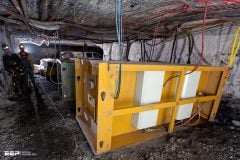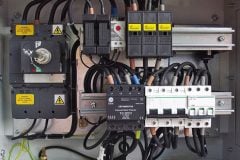Problems in the distribution network
The foregoing discussion concentrated on the principles of lightning strikes and how their effects can be mitigated. However, lightning strikes on electrical lines or substations are those that cause problems in the distribution network which come right into our residences and offices.

A direct lightning strike on a conductor of a power line causes extremely high voltage pulses at the strike point, which are propagated as traveling waves in either direction from the point of strike. The crest of the pulse can be calculated as:
V = I × Z
Where:
V is the crest voltage
I is the peak lightning current
Z is the impedance seen by the pulse along the direction of travel.
Impedance Z is equal to half the surge impedance of the line when struck at mid-point and can be approximately as much as 150 Ω. Thus for a peak current of 40 kA, the voltage of the pulse can be as high as 6000 kV. Since the basic insulation level of most systems is much lower than this value, it is clear that such a pulse will cause failure of insulating components along the line.
It is therefore necessary that no direct strike must be permitted on the overhead power line’s phase conductors.
The shield wire is earthed at each transmission tower and thus the lightning current safely passes into the groundmass.
The clearance between the phase conductors and the shield wire must be selected so that air space between them does not breakdown by the high impulse voltage generated in the shield wires. This is easily achievable in systems of 66 kV and higher.
Even when protected in the above manner, the flow of the pulse of lightning current in the shield wire causes an induced voltage pulse in the phase conductors. These being much smaller in value than the direct pulse safely pass along the line without causing any insulation failure. To protect the equipment at the termination point of the overhead lines (such as circuit breakers, transformers, measuring devices, etc.), lightning surge arrestors are provided at the point of termination. These arrestors absorb any surges in the line and prevent them from traveling into the substation equipment.
These arrestors are essentially non-linear resistors in a porcelain housing which at normal voltages present a very high resistance. They are designed to break down at voltages above the highest system operating voltage (but lower than the basic insulation level of the system) thereby becoming good conductors and pass the energy of the lightning impulse to the ground. Once the voltage comes down (after the discharge of the pulse is over) the arrestors return to their original high-impedance state.
The arrestors are placed on structures and their line terminals connected to each phase of the line. The other end of the arrestor (ground terminal) is connected to the substation grounding system through short ground conductors of adequate cross-sectional area.
Arrestors can also be optionally provided with surge counters for the purpose of monitoring their action.
Resource: Practical grounding, bonding, shielding and surge protection by G. Vijayaraghavan











ive seen HV power lines where there is no ‘shield’ conductor.
in other words, at the same vertical height would be, for example, 3 main conductors.
all are at same level – with no ‘shield’ conductor above them.
certainly not every single HV power line circuit in the entire country would have this extra shield conductor.
in the case of either;
a) no shield wire, or
b) even with shield wire – where the lightning would have a direct hit to a powered phase circuit
what would typically happen in this case?
are not HV transformers rated to withstand such spikes without sacrificing their life?
and / or are there other parts of the system that tries to clamp this lightning spike?
It good
This was helpfull thank you